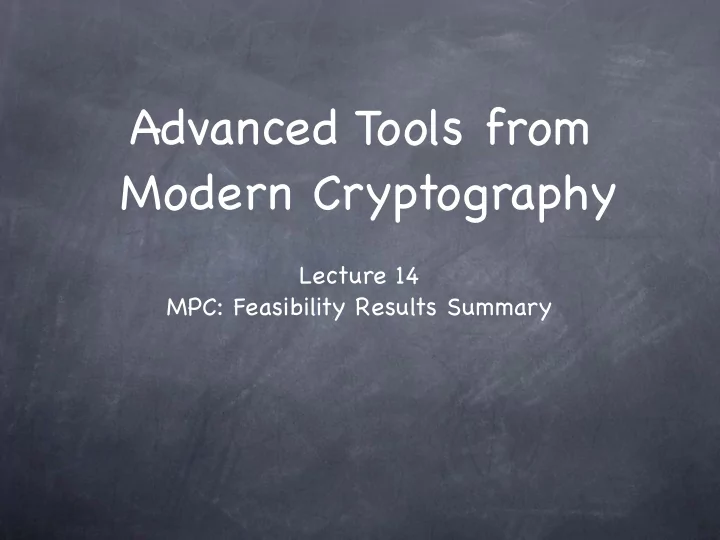

Advanced Tools from Modern Cryptography Lecture 14 MPC: Feasibility Results Summary
������ �� ��������� ����������� ���� ���������� ���������� ����� ����� ������������ ����������� ������ �������� �������������� ������ ��������� ���������� ���� ���������������������� ���������� ����������� � ��������� ����������� � � ������ ������ ��������� ������� ��������������� ���������� ����������
Basic Dimensions Adversary’ s computational power: PPT adversary, Information- theoretic security Honest majority: Thresholds 1 (no honest majority), ½ and ⅓ Security Level: Passive security, UC security with selective abort, or UC security with guaranteed output delivery Setup: Point-to-point channels, Broadcast, Common Reference String (CRS), OT
General MPC Information-theoretic security Passive with corruption threshold t < n/2 Passive BGW/CCD Passive with OT setup Passive GMW Guaranteed Output UC with t < n/3 BGW Guaranteed Output UC with t < n/2 and Broadcast “Rabin-BenOr” Selective Abort UC, with OT “Kilian. ” (Also: GMW paradigm implemented using OT-based proof) Computational security Passive Composing Yao or Passive GMW with a passive-secure OT protocol Standalone GMW: using ZK proofs Selective Abort UC, with CRS Composing Kilian with a CRS-based UC-secure OT protocol
Beyond General MPC In each model, only some functionalities will be realisable without setups (will call them trivial functionalities) Question: which functions are trivial in each model?
Trivial Functionalities: Passive Information-Theoretic For n-party information-theoretic passive security, which functions for each corruption threshold t Called the Privacy Hierarchy All n-party functions appear at level ⌊ (n-1)/2 ⌋ in this hierarchy (e.g., by Passive-BGW). Some are at level n: e.g., XOR or more generally, group addition. Level n-1 is same as level n. At all intermediate levels t, examples known to exist which are not in level t+1 Open problem: characterise all functions at level t (or even at level n) For n=2, we do have a characterisation for all t (t=0,2)
Trivial 2-Party Functionalities: Information-Theoretic Passive security. (Restricting to symmetric SFE.) Deterministic SFE: Trivial ⇔ Decomposable
Decomposable Function Decomposable 1 3 0 1 1 2 3 0 0 0 1 3 0 1 1 1 2 1 1 2 2 2 2 3 1 1 0 1 3 4 4 3 4 4 3 “Max” ⌈ (x+5y)/2 ⌉ XOR (no ties) Undecomposable 0 1 1 1 2 1 1 4 2 0 4 5 2 0 0 4 3 3 2 4 3 3 1 0 1 4 2 1 1 “Spiral”
Trivial 2-Party Functionalities: Information-Theoretic Passive security. (Restricting to symmetric SFE. Deterministic SFE: Trivial ⇔ Decomposable Open for randomized SFE! Standalone security Deterministic SFE: Trivial ⇔ Uniquely Decomposable and Saturated
� � � Decomposable Function Decomposable 1 3 0 1 0 0 1 3 0 1 1 1 2 1 1 2 2 2 2 3 1 1 0 3 4 4 3 4 4 3 Not Uniquely Not Saturated Decomposable This strategy doesn’ t correspond to an input 1 2 3 4
Trivial 2-Party Functionalities: Information-Theoretic Passive security. (Restricting to symmetric SFE. Deterministic SFE: Trivial ⇔ Decomposable Open for randomized SFE! Standalone security Deterministic SFE: Trivial ⇔ Uniquely Decomposable and Saturated UC security Trivial ⇔ Splittable
Trivial Functionalities: PPT Setting Under the assumption that there is a passive-secure protocol for OT (a.k.a. sh-OT) For passive & standalone security: all n-party functionalities are trivial For UC security: very few are trivial irrespective of computational hardness Recall, for n=2: UC trivial ⇔ Splittable. Gives explicit characterisation (e.g., functions like f(x,y)=x) Full characterisation open for n ≥ 3
Completeness We saw OT can be used to (passive- or UC-) securely realise any functionality i.e., any other functionality can be reduced to OT The Cryptographic Complexity question: Can F be reduced to G (for different reductions)? F reduces to G: will write F ⊑ G G complete if everything reduces to G F trivial if F reduces to everything (in particular, to NULL)
PPT Setting: Completeness PPT Passive security and PPT Standalone security Under sh-OT assumption, all functions are trivial — and hence all are complete too! PPT UC security, n=2: Recall, only a few (splittable) functionalities are trivial Under sh-OT, turns out that every non-trivial functionality is complete
IT Setting: Completeness Information-Theoretic Passive security (Randomized) SFE: Complete ⇔ Not Simple What is Simple?
Simple vs. Non-Simple (0,1) (1,1) 1 3 (2,2) (1,2) 0 1 3 Simple: 2 2 3 Each connected (0,3) (3,3) component is a (2,3) Edge ((x,a),(y,b)) biclique exists iff f(x,y)=(a,b) 0 1 (0,0) (0,0) 0 0 0 (1,0) (1,0) 1 0 1 (1,1) (1,1)
IT Setting: Completeness Information-Theoretic Passive security (Randomized) SFE: Complete ⇔ Not Simple What is Simple? In the characteristic bipartite graph, each connected component is a biclique If randomized, within each connected component w(u,v) = w A (u) ⨉ w B (v)
Simple vs. Non-Simple (Randomized) ½ (0,0) ( ⊥ ,0) Optionally one-sided ½ coin-toss (0,1) ( ⊥ ,1) ½ Simple: within (1,0) ( ⊥ , ⊥ ) Edge ((x,a),(y,b)) connected weighted with ½ (1,1) component Pr[ (a,b) | (x,y) ] w(u,v) = w A (u) ⋅ w B (v) where x,y inputs and a,b ¾ (0, ⊥ ) ( ⊥ ,0) outputs ¼ Rabin-OT (1, ⊥ ) ( ⊥ ,1) ¾ ¼ ( ⊥ , ⊥ )
IT Setting: Completeness Information-Theoretic Passive security (Randomized) SFE: Complete ⇔ Not Simple Information-Theoretic Standalone & UC security (Randomized) SFE: Complete ⇔ Core is not Simple What is the core of an SFE? SFE obtained by removing “redundancies” in the input and output space
A Map of 2-Party Functions Non-Simple * OR * “ Spiral” Decomposable Uniquely * “(x+5y)/2” * XOR Decomposable * Max (no ties) Saturated * x Splittable
Recommend
More recommend